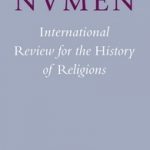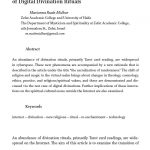Have you ever had your cards read online? …How is it different from reading cards from a deck? In this article all the divination (foretelling) rituals are analysed, in their new, virtual version: what changes in the virtualization process, in terms of the inner logic of believers? In my opinion, in the course of this process, a new logic is emerging, that gains popularity in our cultue – a logic of sactifying randomness.
The artcile (about 13,500 words) was published in Numen: International Review for the History of Religions – a first-rate world-renowned journal in the field of Religious Studies (considered by many scholars in the Humanities as the top Religious Studies journal in the world).
This article presents the phenomenon of divination ceremonies in the virtual realm (internet websites and software) and seeks to identify its theological characteristics, implications and the affinity between this phenomenon and characteristics of alternative spirituality outside of the virtual realm. The core of the article presents a new logic- “sanctified randomness”- as a principle which explains this virtual activity (and alternative spirituality in general).
The virtualization expropriates the logic of traditional rationalizations for divination ceremonies. Accordingly, the discourse of manufacturers and users of virtual divinations sanctifies the virtual realm and presents it as a select sphere for meta-physical activity (involving the soul, God, etc.). The virtual performance of the ceremony cultivates unique characteristics which are expressed both in technical terms and in the creation of a new theology and ethics: preservation of user privacy and avoidance of documentation; extensive options for manipulation on the part of the user; accessibility, automation and immediacy in the performance of the divination; an inflation of divination methods and exposure to a wide array of methods; equal treatment towards the various divination methods (and their cultural origin); tremendous importance placed on experiential illustration methods with a focus on visualization; increasing personalization of divination ceremony characteristics in order to suit user needs; etc. A highly significant phenomenon is the increase of personal responsibility placed on the user in the different stages of the ceremony (choice of divination method, phrasing of the question, implementation of the ceremony, interpretation) in the place of the authority of the priest.
The virtual spiritual discourse demonstrates the continuous mixture and blurring between secularized and religious “classic” rationalizations. Virtual divination therefore serves as an illustration of my claim that in contemporary spirituality there is no contradiction, rather a productive joining among spirituality, magic and technology.
Academic/Non-academic
Academic item
Publisher/Source
Numen – International Review for the History of Religions
Bibliographical citation
Ruah-Midbar, Marianna, “The Sacralization of Randomness – The Theological Imagination and the Logic of Computerized Divination Rituals”, in Numen – International Review for the History of Religions 61.5-6 (2014): 619-655.








